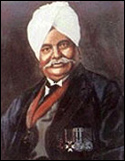 In 1873, Sir Ganga Ram, after a brief service in Punjab PWD, devoted himself to practical farming. He obtained 50,000 acres of barren land from the government in Montgomery district (a former Punjab province in British India). In three years, he converted the vast desert into smiling fields irrigated by water lifted by a hydroelectric plant and running through a thousand miles of irrigation channels, all constructed at his own cost. This was the biggest private enterprise of the kind, unknown and unthought-of in the country before.
In 1873, Sir Ganga Ram, after a brief service in Punjab PWD, devoted himself to practical farming. He obtained 50,000 acres of barren land from the government in Montgomery district (a former Punjab province in British India). In three years, he converted the vast desert into smiling fields irrigated by water lifted by a hydroelectric plant and running through a thousand miles of irrigation channels, all constructed at his own cost. This was the biggest private enterprise of the kind, unknown and unthought-of in the country before.
Sir Ganga Ram earned millions most of which he gave to charity. In the words of Sir Malcolm Hailey, the Governor of Punjab, “He won like a hero and gave like a saint.”
Sir Ganga Ram was a great engineer and a great philanthropist. In 1900, Lord Curzon appointed him superintendent of works in the Imperial Durbar, in connection with the accession of King Edward VII. He finished the work at the Darbar managing its manifold problems and challenges. But his name was not included in the New Year Honors list. He retired prematurely from service in 1903.
Sir Ganga Ram was born in 1851 in Mangtanwala, a small village of Punjab province in British India, now in Punjab, Pakistan. He was educated at Thomason College of Civil Engineering (now known as the Indian Institute of Technology Roorkee) and passed the final lower subordinate examination with gold medal in 1873.
He was a leading philanthropist and agriculturist of his time and established the Renala hydropower station in Renala Khurd, Punjab, in 1925. He became Superintending Engineer in Patiala State for the capital’s reconstruction project after his retirement. Amongst his works were Moti Bagh Palace, Secretariat Building, New Delhi, Victoria Girls School, the law courts, and police station.
Sir Ganga Ram built a unique travelling facility, Gora Train (horse pulled train), at Jaranwala in Faisalabad. The train, with two simple trollies, pulled on a narrow rail track with horse instead of railway engine from Buchiana station to Gangapur. In 2010, Faisal Abad district authorities resumed the service by giving it ‘cultural heritage’ status.











